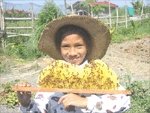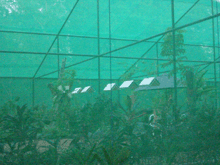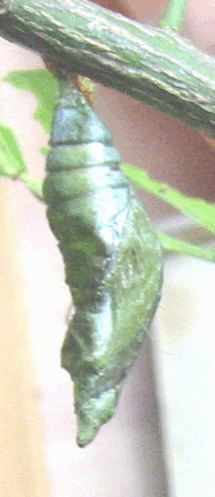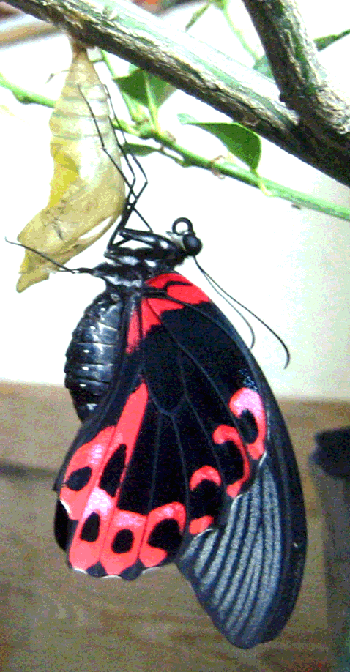|
|
|
|
|
|
|
|
|
|
|
|
|
|
|
|
|
|
|

|
|
| 05 March
2003: Sarrah Sinead, 7 years, holds a comb of honey for a souvenir photo. Photo
by Rene Quinquito |
|
|
|
|
|
26 May 2006 Wackwack Golf and Country Club:
The
Butterfly Story
Story / Photos by:
Rene Icasiano-Quinquito
Projects
Consultant
Attn: EDS -
Mandatory Credit |
|
|
For
generations men embarked on programs for increased farm production to meet the food
requirements of a burgeoning global population.
Pest was the
word used to describe other living organisms that were in conflict with our agricultural
pursuits, one of these is the butterfly.
It was a survival tale of competing species.
Men with his chemicals did complex
scientific research to favor his domination in the enmity and ensure the annihilation
of his steep rival.
At this age of hi-tech gadgetry, appreciation
for most things that resulted from this tussle is learnt.
Then there was the dream to transform a cellular
telephone switching station into a refuge for these be-winged
jewels.
A folded leaf dangling from a branch morphing into
a flying creation, is nature's special applause to the birth of a sanctuary - the
Wackwack Golf butterfly haven.
The voracious caterpillar, the butterfly's young larvae,
man’s incessant agricultural competitor, now has a home.
The reverie was now real. |

05 May 2006 6:36AM Butterfly enclosure.
|
|
“Keep them caged-in, make them safe", were the words streaming into my mind as a
technology consultant for this special project.
Perhaps this was a reminding structure on the
manifestation of our inner conscientious guilt and thoughtful sensitivity towards the
casualties of our struggle for our own continued existence.
Nomenclature and
classification
Among the insect
world, around 140,000 species belong to the order Lepidoptera, which includes both the
butterflies and moths. |
|
Most people like to think that they know the difference between butterflies, generally
day-flying and have thickened ends to their antenna and moths, which are generally
night-flying with tapered or feathery antennas.
Specialists in the subject do not generally accept such
divisions because there are so many exceptions.
Many butterfly species have common names and different ones
in other languages.
A scientific name or Latin name is the same in every
language and so it is used as a precise means of communicating to others the actual
species that is being discussed.
The names of species consist of two parts. Genus, the first
word gives information about the relationship of a species to other species.
When a study shows that the relationship is not as was
first thought then this word is changed, according to very precise Codes of Nomenclature.
Books written at different times may have different
names for the same species. |

18 May 2006 7:20PM - Night-time release of
packaged butterflies inside the enclosure |
New species are
constantly discovered and given new names.
Even species may be divided up into smaller
subcategories, such as subspecies and forms.
Heliconius Melpomene, for example, has over 30 different
patterns to the wings, which to the uninitiated look like different species.
Many of these are almost exactly mimicked by patterns on
the wings of a different species like Heliconius Erato.
The fairly common Mormon, Papilio Polytes, is |
|
one of the easiest swallowtail butterflies to breed in
captivity.
It is another of
the black group, although there is a substantial band of white spots on the upper side of
the wings of the male. The females have several different patterns, although all can
interbreed with the single type of male.
Pairing takes place readily and the ova are laid on
citrus tree species, often in large numbers.
The majority of female butterflies or moths lay 100
or more eggs during their lifetime, but some may lay as many as 6,000 eggs.
Many lay their eggs one at a
time, but others such as the Gypsy Moths, lay them in clusters of 100 or more.
Butterfly Egg
Eggs are
about the size of a pinhead, dull colored to help conceal them from bugs, ants |
 |
|
or beetles that might eat them.
Some eggs contain food for the developing caterpillar
while others contain poisons that help prevent them from being destroyed by predators.
The ova or egg hatches into a young caterpillar in
about four days, gorging itself with leaves from the host plant for about two weeks.
Some caterpillars eat more than 25,000 times their
body weight before it reaches full size!
Caterpillars shed their skin in order to grow
which usually happens four times during this stage. |
|
|
 |
|
Pupa
Once fully grown, the caterpillar stops eating and begins to look
for a place to go through its next stage. The caterpillar then splits its skin for one
last time revealing the pupa.
Many moth caterpillars use their silk to spin a cocoon that
surrounds the pupa. This is the stage by which a caterpillar turns into a butterfly or
moth. The pupa is a hard shell that cannot crawl around or fly.
Most pupae are brown, green or reddish to help them blend
into the surrounding background. Some even look like leaves. A butterfly pupa is called a
chrysalis.
Inside this hard shell of the pupa, a butterfly or moth is
forming. After several weeks or months, the butterfly or moth emerges.
The adult comes out of the pupa looks nothing like the
caterpillar that it came from.
Reaching the stage of its primary goal to find a mate and lay eggs, starting the cycle all
over. |
|
 |
|
|